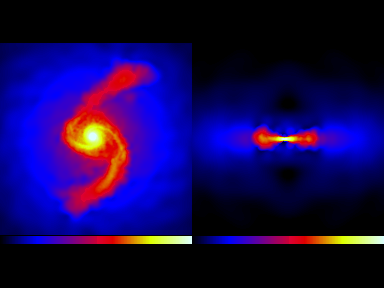Dynamical Rotational Instability of the First Hydrostatic CoreThis animation shows the dynamic rotational instability of the first hydrostatic core. This can occur during the collapse of a molecular cloud to form a star. This animation is from the first three-dimensional calculation ever to follow the collapse of a molecular cloud core all the way to the formation of a star. The calculation has to resolve 7 orders of magnitude in length scale and 17 orders of magnitude in density. There are several phases of collapse of a molecular cloud before a star is formed (Larson 1969). As the collapse begins, the gas in the cloud remains at the same temperature (isothermal collapse) because the heat generated by compression of the gas can be freely radiated away. However, eventually, as the collapse accelerates, the rate of heating overwhelms the cooling rate and the gas at the centre of the cloud heats up. This occurs at about the same time as the gas at the centre becomes optically thick to the infrared radiation emitted from dust grains. The increasing temperature quickly stops the collapse at the centre of the cloud and a pressure-supported hydrostatic `core' forms. The size of this object is roughly 5 AU (the radius of Jupiter's orbit) across. In the absence of rotation, the core slowly accretes gas that falls on to it from the envelope which is still collapsing isothermally. As it does so, its central density and temperature increase. Eventually, it reachs 2000 K at which point molecular hydrogen (the main constituent) starts to dissociate. This allows the core to begin collapsing again because compressional heating of the gas can be used to dissociate the molecular hydrogen instead of heating up the gas (i.e. it collapses nearly isothermally again). This time the collapse does not stop until a stellar core forms. This is the beginning of the star, although at this stage it only has about the mass of Jupiter. If the initial molecular cloud was rotating, however, a different evolution can occur. If the pressure-supported hydrostatic core that forms is rotating fast enough it can undergo a dynamic bar instability. This is the case in the animation. The animation shows the core looking down the axis of rotation (left) and in a slice through the core (right). Each of these two panels is about 100 AU across. The hydrostatic core is rotating so fast that it is flattened. After a short time it goes from begin round to a bar-shaped object. The ends of the bar rotate slower (the same way that the planets revolve around the Sun slower the farther out they are) creating spiral arms. These create gravitational torques that transfer angular momentum from the centre of the object into the ends of the arms. The result is that some gas forms a large disc while, in the centre, the density and temperature increase rapidly. Molecular hydrogen dissociates at the centre and the collapse to form the star occurs. The calculation stops just after the star forms (although it is much too small to see in this animation). Results from this calculation were published in Bate 1998.
|

